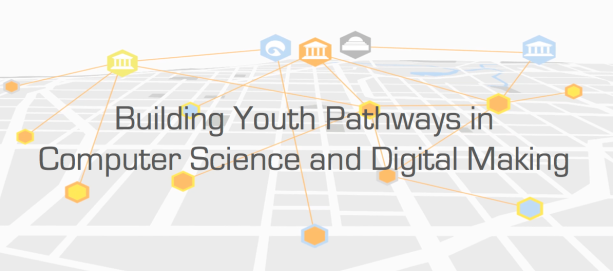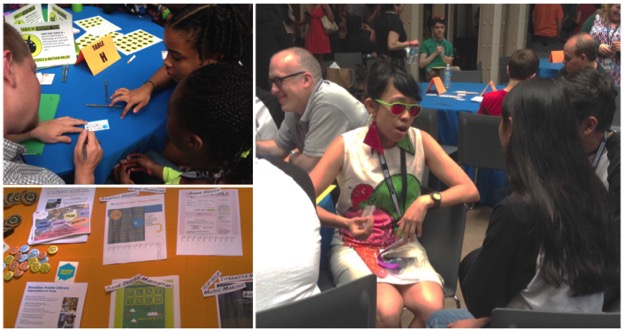 We are excited to announce and invite participation in the Building Youth Pathways in Computer Science and Digital Making (CS-Paths) initiative, a partnership between Hive Research Lab and the Mozilla Hive New York City Learning Network to support the learning and identity building trajectories of teens engaging in computing and digital making programs. Through this initiative, supported by the Spencer Foundation, Capital One Investing for Good and the Hive Digital Media Learning Fund, we hope to develop and share best practices to help out-of-school organizations create opportunities for learning computer science and digital media making that span multiple experiences and settings. We see organizations like those in Hive NYC as critical nodes within larger city-wide learning ecosystems around technology and as key actors able to ensure that youth from non-dominant communities thrive in these ecosystems.
We are excited to announce and invite participation in the Building Youth Pathways in Computer Science and Digital Making (CS-Paths) initiative, a partnership between Hive Research Lab and the Mozilla Hive New York City Learning Network to support the learning and identity building trajectories of teens engaging in computing and digital making programs. Through this initiative, supported by the Spencer Foundation, Capital One Investing for Good and the Hive Digital Media Learning Fund, we hope to develop and share best practices to help out-of-school organizations create opportunities for learning computer science and digital media making that span multiple experiences and settings. We see organizations like those in Hive NYC as critical nodes within larger city-wide learning ecosystems around technology and as key actors able to ensure that youth from non-dominant communities thrive in these ecosystems.
With national and local calls to provide meaningful computer science learning experiences to all students, this project aims to address key problems around ensuring equitable access. CS-Paths is included in the White House announcement today that charts progress on President Obama’s Computer Science for All Initiative, alongside incredible work happening across the country, including from many organizations connected the Hive NYC. You can see the full fact sheet that includes our work here.
In this post, we provide some history leading up to this initiative, as well as describe the general activities and intended outcomes of CS-Paths. For New York City-based educators and informal learning organizations who would like to learn more, please consider attending our information session on September 29th, 10am-noon, at MAGNET in downtown Brooklyn.
Background leading to this initiative
Storyboard of an “attendance tracker” prototype, presented during a Hive Research Lab Youth Pathways & Trajectories Design Charrette meeting.
In 2014, HRL invited members of the Hive NYC community to discuss the challenges around supporting the long-term interest-driven pathways in youth and to develop practical designs that might address those challenges. A central focus was to help youth build upon their program experiences, as our case studies indicated that teens in out-of-school programs often faced a critical and vulnerable time period right after a program ends. This is when many young people, despite having an interest in some kind of computing or digital media related area, “fell off their learning pathway,” sometimes because they lacked the understanding or support to find the next learning opportunity that would help them continue and “level up.”
This persistent problem of practice that we identified resonated with Hive members as an issue that was both important and concrete enough to be actionable within our community. As one Hive member put it:
“We know how to build excitement and enthusiasm during the program. The difficulty is how to take the excitement from one program to the next. Who tells youth what possibilities are available next? How do youth find and register for them? How is the youth’s experience at one place recognized and carried over to the next institution?”
Following that meeting, HRL engaged in a participatory knowledge building process lasting several months, facilitating discussions at member events, presenting relevant empirical findings from our ongoing case studies, and highlighting other reports from the wider literature base of out-of-school learning and youth development. We also began to focus on the educator practice of “brokering,” or connecting program participants to future learning opportunities, which might include fellowships, internships, events, out-of-school programs, and online tools and communities. These activities culminated in a community-developed white paper that has helped to spark a groundswell of interest in ways to better understand and enact brokering as a means to support youth pathways, both among the research and practice-oriented communities.

An idea to develop “exit plans” for all youth as a program brokering practice. Presented by Hive members during a community meet-up.
However, much of our work up to this point has heavily oriented towards basic research that focused on following and understanding young people as they engaged with technology-related interests. The CS-Paths project aims to take a more directly applied approach that utilizes collaborative design-based research methods. We’ll be working with organizations to put ideas into practice, test and iterate on them, build out our theories, and create resources to share with out-of-school educators both in the Hive network and beyond. Given that brokering is such an essential component of supporting interest-driven pathways, how do we amplify and improve the ways we connect youth to opportunity? We hope the CS-Paths initiative will help us answer that question.
Introducing the CS-Paths Initiative

Brokering interventions piloted at city-wide youth technology showcase event Emoti-Con!. Top left and right: a “networking hour” with digital making professionals; bottom left: a “Hive opportunity table” displaying program registration flyers.
CS-Paths is a research-practice partnership to develop practical interventions that promote brokering in out-of-school contexts. These interventions may comprise refinements to existing program practices, organizational tools or routines, or new approaches altogether. Participation is open to any NYC-based organization that offers computer science or digital making out-of-school programming to teens and participants may choose to engage in one or both of the following ways:
- As CS-Paths Design Partners, who will collaborate with HRL on the design, testing and iteration of brokering interventions. Initiative partners will receive a modest stipend to cover participation time, as well as ongoing research support through the evaluation of interventions that come out of the initiative.
- As CS-Paths Working Group Partners, who can attend regular working group sessions to discuss and reflect on the practice of brokering, as well as hear about the ongoing pilots happening within CS-Paths partner organizations. Members of the working group will gain a deeper understanding of ways to enhance their brokering practices in their respective organizations.
A final outcome of this initiative will be the production of a “CS opportunity brokering tool kit”—a collection of best practices for front-line educators that will enhance their ability to broker learning opportunities to young people in their computing and digital making programs. This toolkit will be disseminated to the hundreds of organizations that are part of the global Hive ecosystem, and to the broader field of out-of-school learning organizations dedicated to creating equitable access to digital learning.
The project also aligns with another line of work that’s been more recently developed in our lab, focusing on visions of CS education. In the CSed Visions project, we’ve been bringing together stakeholders from across the Hive network and beyond to think about how the discourse around computing education is currently playing out, seeing that there is a strong emphasis on rationales linked to jobs and economic development. We knew from extensive work with Hive NYC that the visions and possibilities for what computing education and learning with digital media could look like were much broader, encompassing ideas of creative computing, digital inclusion, citizenship, social activism, critical computing and more. So in the CS-Paths initiative, we will also seek to capture and promote a diverse range of pathways that youth forge, supported by organizations that have expansive ways of thinking about ‘what counts’ as a computing pathway.
We hope this initiative will be of interest to our strong and passionate community of educators!
